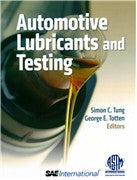Description
Automotive Lubricants and Testing provides a comprehensive overview of various lubrication aspects of a typical powertrain system, including the engine, transmission, driveline, and other components. It also covers lubrication fundamentals and lubricant testing methods that are influenced by lubricant additive formulation and engine hardware changes.
This handbook contains 26 chapters covering the powertrain, transmission, chassis, and drivetrain systems. In addition, the advanced lubrication and tribochemistry of powertrain systems have been included, such as diesel fuel lubrication, specialized automotive lubricant testing development, and biodegradable automotive lubricants.
Automotive Lubricants and Testing also covers the major test methods for typical engine components (gasoline and diesel), engine oil characteristics, engine material evaluations, and the current industrial standard test methods for chassis and drivetrain systems.
Author: Tung and Totten
Published: 2012
Format: Hardback
Pages: 501
Excerpt: Controlling Contaminants: Acids and Deposits. Another form of contamination control is performed by metallic detergents. Detergents are capable of controlling contaminants such as acids, produced on combustion, by neutralization so that these acidic materials do not cause rust in the engine. Detergents are also able to control contamination by the formation of micelles, which are capable of solubilizing one unit of liquid deposit precursor for each unit of additive present. Second, they peptize solids of the size range 0-10 nm. They are also capable of forming films around deposit particle precursors to which they are physically adsorbed.
Table Of Contents:
Part 1: Automotive Tribology and Lubrication Fundamentals
Fundamental Principles of Contact and Lubrication
Automotive Lubricants
Lubricant Properties and Characterization
Controlling Lubricant Degradation through Performance Specification
Elastohydrodynamic Lubrication Film Tests and Tribological Bench Tests
Automotive Engine Hardware and Lubrication Requirements
Part 2: Automotive Lubricant Testing, Lubricant Performance, and Current Lubricant Specifications
Gasoline Engine and Diesel Engine Powertrain Systems
Automotive Bearing Systems—Journal Bearings
Testing and Evaluation of Lubricating Greases for Rolling Element Bearings of Automotive Systems
The Drivetrain System
Gear Oil Screen Testing with FZG Back-to-Back Rig
Problems and Opportunities Regarding the Lubrication of Modern Automotive Engines
Bench Performance Test Methods for Lubricated Engine Materials
Current and Future Specification of Lubricant Performance
Automatic Transmission Lubricants
Other Automotive Specialized Lubricant Testing Including Manual Transmission, Rear Axle, and Gear Box Lubricant Testing and Specification
Design for Reduced Wear
Nonpetroleum-Based, No/Low-Sulphur, Ash, and Phosphorous, and Bio-No-Toxicity Engine Oil Development and Testing
Part 3: Specialized Automotive Lubricant Testing and Future Automotive Applications
Current and Future Advances in Materials Development for Tribological Applications
Surface Analysis and Tribochemistry of Automotive Engine Components
Tribology and Fine Automotive Mechanical Systems
Analysis of In-Service Automotive Engine Oils
Diesel Fuel Lubrication and Testing
Filters and Filtration Testing of Automotive Fuels and Lubricants
Dynamic Friction Characterization and Modeling of Tripod Constant Velocity Joints
Biobased Automotive Lubricants
Appendix: List of Referenced Documents
Index




